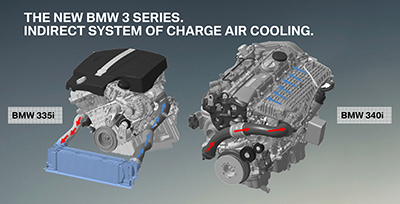The biggest change in the ’16 BMW 3-Series lies under the hood where the German automaker debuts its all-new 3.0L twin-scroll turbocharged I-6 engine as part of a midcycle overhaul of the company’s bread-and-butter sports sedan.
The world premiere of the B58 engine comes in the 340i, where it replaces the previous-generation N55 engine found in the 335i, a 3-time Ward’s 10 Best Engines winner. Both the old and new powerplants feature BMW’s trademarked TwinPower technology that includes twin-scroll turbocharging, direct fuel injection, dual-Vanos variable camshaft control and Valvetronic variable valve control.
The new B58, however, is part of BMW’s modular engine family that gives the company wide flexibility to use the same 0.5L-per-cylinder aluminum-block architecture across a number of gasoline and diesel engines.
The modular engine is built of lightweight, thermally optimized aluminum, with a closed-deck crankcase design in which cylinder water jackets are closed at the top to improve rigidity. The cylinders feature high-strength, twin-wire, arc-sprayed coatings that reduce friction, save weight and allow easier heat management through thinner cylinder walls.
Efficient Dynamics technologies incorporated into the engine include stop/start, intelligent alternator control and a smaller more powerful servomotor in the more-compact fourth-generation Valvetronic system.
BMW 3-Series and X1 Go Modular
The B58 engine features a bore and stroke of 82 mm/94.6 mm versus the N55’s 84 mm/89.6 mm, a slightly higher displacement at 2.998L (vs. 2.979L) and a higher compression ratio at 11:1.
In the 340i, the engine produces 320 hp at 5,500-6,500 rpm and 332 lb.-ft. (450 Nm) of torque at 1,380-5,000 rpm. The figures represent an improvement of 20 hp and 32 lb.-ft. (43 Nm) of torque compared to the ’15 model.
The turbocharger is larger, with a 6% increase in the turbine wheel size and a 10% increase in the compressor wheel diameter, along with a higher maximum rpm, resulting in a 20% increase in boost pressure. The intake is fed by an all-new water-to-air intercooler integrated into the intake plenum which lowers the charged air volume between the compressor and the intake, improving performance by maintaining more even temperatures in the intake.

Preserving engine temperature is the goal behind the modular unit’s engine-mounted encapsulation system – much like an insulating blanket that allows the engine to retain heat for up to 36 hours after shut down. BMW says the retained heat helps the B58 start easier, warm up quicker and reduce emissions.
The modular design first appeared in the ’15 Mini, in 1.5L 3-cyl. and 2.0L 4-cyl. configurations, the latter of which (codenamed B46) will be offered in the ’16 X1 xDrive28i CUV, replacing the N20 4-cyl. In the X1, the engine produces 228 hp at 5,000 rpm and 258 lb.-ft. (350 Nm) of torque between 1,250 rpm and 4,500 rpm. BMW says the power output is tops in the X1’s entry-CUV class and is capable of propelling the 3,660-lb. (1,660 kg) 5-seater from 0-to-60 mph (97 km/h) in 6.3 seconds.
U.S. EPA mileage figures aren’t available, but BMW says the X1 xDrive28i recorded carbon-dioxide emissions of 152 – 149 g/km in the EU test cycle (variance due to tire fitment).





